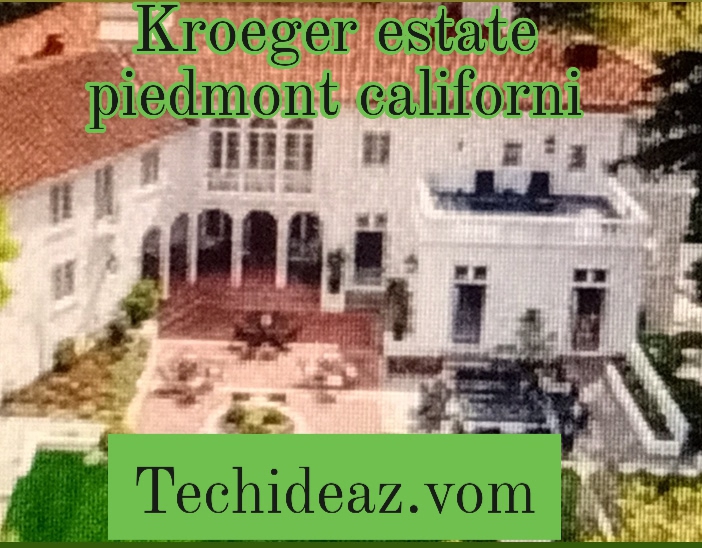Kroeger Estate: A Majestic Property in Piedmont, California
Piedmont, California, is a city known for its rich history, stunning views, and an array of grand estates. Among the many properties in this desirable location, the Kroeger Estate stands out as a historical gem with remarkable architectural features and a fascinating legacy. Located in the beautiful East Bay Area, this estate is not only a testament to the opulence of a bygone era but also a symbol of the city’s transformation from an exclusive suburban enclave to a sought-after residential area for today’s affluent residents.
In this article, we’ll explore the history of the Kroeger Estate in Piedmont, its architectural significance, the story of its original owners, and its legacy today. We will also discuss the appeal of Piedmont as a location for luxury living and the factors that make the Kroeger Estate a defining landmark in this prestigious part of California.
Introduction: What is the Kroeger Estate in Piedmont, California?
The Kroeger Estate is a grand estate located in the city of Piedmont, which is nestled within the East Bay region of California. Piedmont itself is renowned for its tree-lined streets, historic homes, and proximity to the cultural and economic hub of San Francisco Bay Area. The Kroeger Estate, with its expansive grounds, historical architecture, and connection to the city’s heritage, has become a significant part of the Piedmont landscape.
Piedmont was originally developed in the late 19th century as an exclusive residential area for wealthy families. Over time, it has evolved into one of the most desirable suburban communities in California. The Kroeger Estate, as one of the premier properties in the area, embodies the charm and elegance of Piedmont’s early history.
The History of the Kroeger Estate
The Kroeger Family Legacy
The Kroeger Estate is named after the influential Kroeger family, which played a crucial role in the development of the estate and the surrounding area. The family’s wealth and prominence stemmed from their successful ventures in industries such as real estate and manufacturing. The Kroegers were well-established in Piedmont and were known for their commitment to high-quality craftsmanship, luxury living, and philanthropy.
The estate itself was built in the early 20th century, during a period when Piedmont was experiencing a transformation into an upper-class residential community. This was a time when many affluent families were seeking expansive homes with sweeping views and close proximity to the bustling cities of Oakland and San Francisco.
The original owners of the estate were Charles and Mary Kroeger, who envisioned the property as both a family residence and a showcase for their wealth and status. The family’s commitment to building a lasting legacy is reflected in the lasting impact the estate had on the local community and its continued historical significance.
Architectural Significance
The architectural style of the Kroeger Estate is reflective of the early 20th-century grandeur that characterized many of the grand homes built in the Piedmont area at the time. Designed by a prominent architect, the estate combines classical architectural elements with innovative design features, making it a true masterpiece of its time.
The estate’s grand entrance, ornate detailing, and expansive grounds evoke a sense of elegance and luxury. Its manicured gardens, which are meticulously designed to enhance the natural beauty of the estate, are a key feature that continues to attract attention from visitors and admirers of fine architecture.
Throughout the years, the estate has undergone several renovations and upgrades, but its timeless design and the original vision of its creators remain intact. The property features a blend of traditional and modern elements, which allow it to remain relevant and impressive even in today’s competitive real estate market.
The Design and Layout of the Estate
Size and Scope of the Property
The Kroeger Estate spans several acres, offering expansive grounds that are both private and secluded. The property is designed with both functionality and beauty in mind, blending vast outdoor spaces with intimate indoor living areas. The estate includes multiple buildings, such as the main house, guest houses, and service quarters, as well as pools, gardens, and expansive lawns.
The home itself features grand living spaces, including multiple bedrooms, dining areas, and entertainment rooms, making it suitable for large gatherings, private family events, or hosting distinguished guests. The layout of the estate emphasizes luxury and comfort, with an emphasis on open spaces, natural light, and serene views of the surrounding landscape.
Gardens and Landscaping
One of the most notable aspects of the Kroeger Estate is its gardens and landscaping. Designed by some of the most renowned landscapers of the time, the gardens feature a blend of formal and natural designs that highlight the beauty of the property. The estate boasts manicured rose gardens, mediterranean-style terraces, and flower-lined pathways that lead to peaceful corners of the estate.
The landscaping is designed to complement the property’s historical architecture, enhancing its aesthetic appeal and providing a tranquil space for reflection and leisure. The gardens are carefully maintained to preserve their timeless beauty, and today, they continue to be a defining feature of the property.
Piedmont, California: The Ideal Location for Luxury Living
Why Piedmont is a Desirable Location
Piedmont, California, is one of the most desirable suburban communities in the San Francisco Bay Area. Known for its exclusive nature, the city offers a combination of luxury living, top-tier schools, and proximity to San Francisco and Oakland.
Piedmont’s streets are lined with large, historic homes, and the city is home to many prominent residents, including business leaders, entrepreneurs, and celebrities. The city’s low crime rate, excellent public services, and beautiful parks make it an attractive place to raise a family or retire.
Moreover, Piedmont is well-connected to the broader Bay Area via nearby freeways and public transit, offering residents the ability to live in a peaceful suburban environment while still having access to the urban amenities of nearby cities.
The Kroeger Estate’s Role in Piedmont’s Development
The Kroeger Estate played an important role in the early development of Piedmont as a luxury residential area. As one of the earliest high-profile properties in the region, it set a precedent for other affluent families to build large estates in the area, helping to define the city’s upscale character.
Over the years, the estate has served as an anchor point for the community, representing the wealth, prestige, and cultural richness that has characterized Piedmont for more than a century.
The Legacy of the Kroeger Estate Today
Preservation of Historical Significance
Despite changes in the surrounding area and the evolution of the Piedmont community, the Kroeger Estate remains a historical landmark. It is carefully preserved by its current owners, who recognize the importance of maintaining the property’s legacy while adapting it to the needs of modern living.
The estate is also recognized by local heritage organizations, and its preservation is an example of the commitment to protecting Piedmont’s architectural and cultural heritage. Today, it continues to serve as a reminder of the opulence and sophistication that characterized the early 20th century in California.
Current Ownership and Use
Currently, the Kroeger Estate remains a private residence, and its owners continue to maintain the property in pristine condition. The estate is rarely open to the public, and access is generally limited to private tours or special events. However, the influence of the Kroeger family and the estate’s architectural beauty ensures that the property remains an important part of Piedmont’s cultural fabric.
Conclusion: A Historic Gem in Piedmont’s Landscape
The Kroeger Estate in Piedmont, California, represents a fusion of historical significance, architectural beauty, and luxury living. With its origins deeply rooted in the city’s development, the estate remains one of Piedmont’s most iconic landmarks. Its history, rich design, and carefully preserved features make it an enduring symbol of the community’s exclusive, affluent character.
Whether you are drawn to its architectural grandeur, its immaculate gardens, or its role in the story of Piedmont’s rise as a luxury residential enclave, the Kroeger Estate remains an unparalleled example of California’s rich heritage. Today, it continues to inspire admiration and respect, making it a cherished piece of Piedmont’s history and a lasting testament to the elegance of a bygone era.
FAQs about the Kroeger Estate in Piedmont
1. Where is the Kroeger Estate located?
The Kroeger Estate is located in the affluent city of Piedmont, California, which is situated in the East Bay Area of the San Francisco Bay Area.
2. Who were the original owners of the Kroeger Estate?
The estate was originally owned by Charles and Mary Kroeger, who were influential figures in the early 20th century in Piedmont. Their wealth and success in industries like real estate helped establish the estate’s prominence.
3. What architectural style is the Kroeger Estate?
The Kroeger Estate is characterized by early 20th-century grandeur, featuring classical architectural elements combined with innovative design to create a timeless masterpiece.
4. Is the Kroeger Estate open to the public?
Currently, the Kroeger Estate is a private residence, and access to the property is limited. It is occasionally open for private tours or events, but generally, it remains a private home.
5. How can I visit Piedmont and view the Kroeger Estate?
While the Kroeger Estate itself is not generally open to the public, visitors to Piedmont can explore the city’s many public parks and historic sites. To view the estate or learn more about its history, it is recommended to check with local heritage organizations for special events or private tours.










